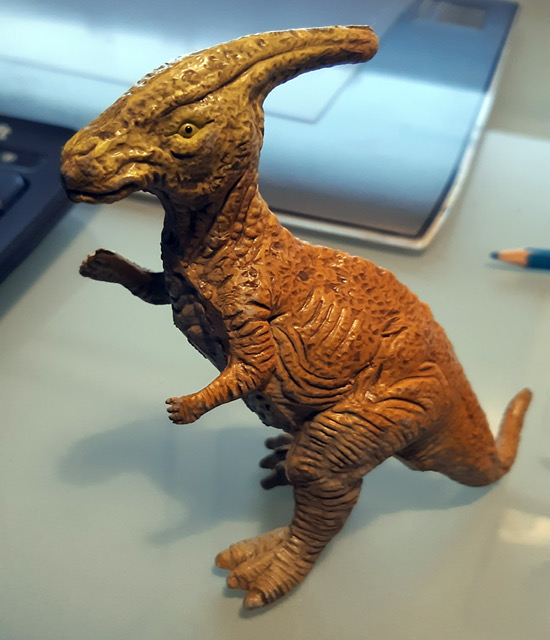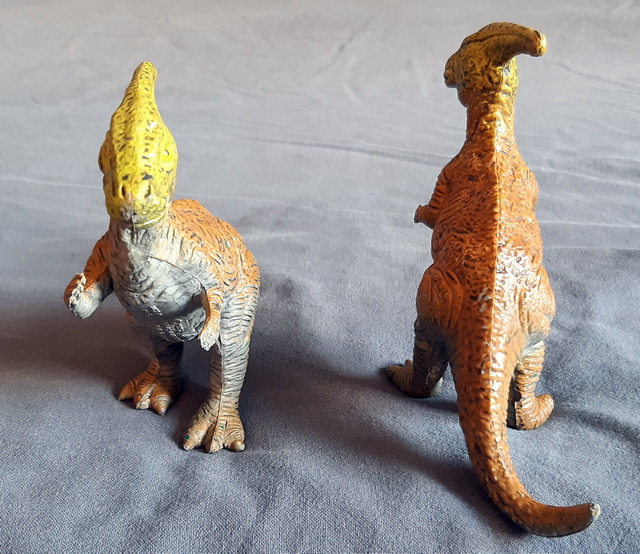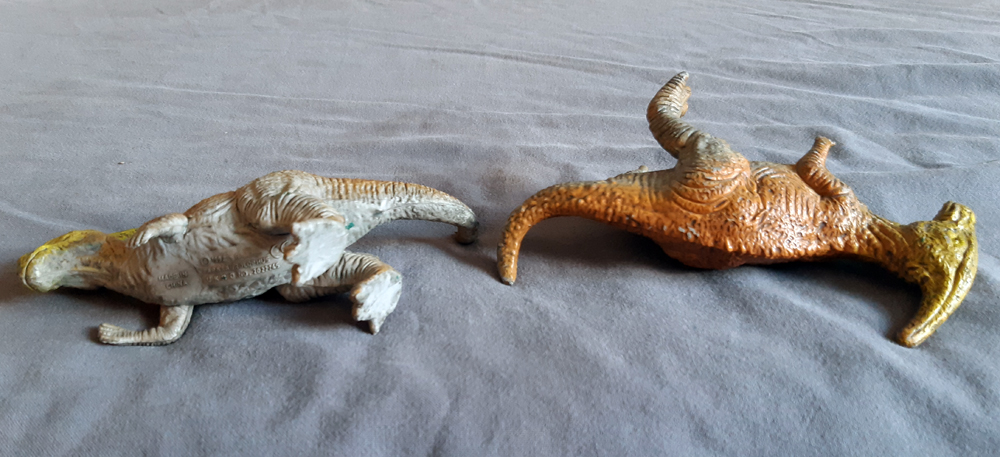Review and photographs by Funk, edited by Suspsy
There are still plenty of UKRD toys from the 1990s left to review, so next in line is the mid-size Parasaurolophus from 1992. Due to its distinctive crest, Parasaurolophus is probably the most familiar hadrosaur, and therefore has a lot of toys to its name. As with many of the other UKRD toys, this one is notable for seemingly being based closely on John Sibbick’s artwork for David Norman’s 1985 book The Illustrated Encyclopaedia of Dinosaurs. Yet the figure also has some differences, which we will get into.

The colouration is where the figure is most different from the artwork; it has a toxic green head, merging into orange red on the body, with a bluish grey underside, with darker colour in creases and wrinkles. Sibbick’s painting has much more muted colours, but it could be said the more lively colouration fits a kid’s toy better. It measures about 14 cm long and 10 cm tall.

Like the painting, the toy is standing in a now outdated tripod-pose, with the arms somewhat awkwardly shuffled, as if it was taking part in a Phil Collins era Genesis music video. Like the painting, the figure also has individual fingers, each with a nail. Of course, hadrosaurs would have had their fingers joined together in mitten-like structures, but at least this toy gets points for the hands not being pronated. The wrinkle details also seem to match the painting well, though the skin looks somewhat saggier on the toy. The painting gives a better impression of the long neural spines on the back, which the toy just shows as uniformly round. A hump, perhaps?

The head is rather different from the painting too, as the crest appears to be much shorter and thicker, which is possibly to prevent eye-poking in toddlers. While the painting clearly shows a beak, the toy seems to have a deeper, more camel-like snout, which is hard to explain. After all, hadrosaurs were commonly known as “duckbills,” so one would think the sculptor would have emphasised this aspect. The painting also has a bit of a skin flap connecting the crest with the neck, but this is not apparent in the toy.

I happen to have two of this figure, which as we saw with the UKRD Pteranodon, enables us to see odd differences between two toys presumably cast from the same molds. As should be apparent from the photos, one figure has one hand much smaller than the other, and the paint on the pupils seems to have been applied more sloppily on one, so that it gets a vertical slit-like effect.

All in all, a pretty decent figure for a child to play with, it is recognisable as the genus it’s supposed to depict, which can’t be said for a few of the more generic looking UKRD toys, like the Allosaurus. And as is the case with the other UKRD toys, this one should be interesting for adult collectors too due to being based directly on some famous, historical palaeoart.
Support the Dinosaur Toy Blog by making dino-purchases through these links to Ebay and Amazon. Disclaimer: links to Ebay.com and Amazon.com on the The Dinosaur Toy Blog are often affiliate links, when you make purchases through these links we may make a commission

Ah yes, those charming UKRD figures! I’m fond of them since they were one of the few readily available figures way back then.
A charming figure that looks older than it is! I’m sure I’ve encountered this model indirectly several times before, just due to how many other toys have probably imitated this sculpt in one scale or another.